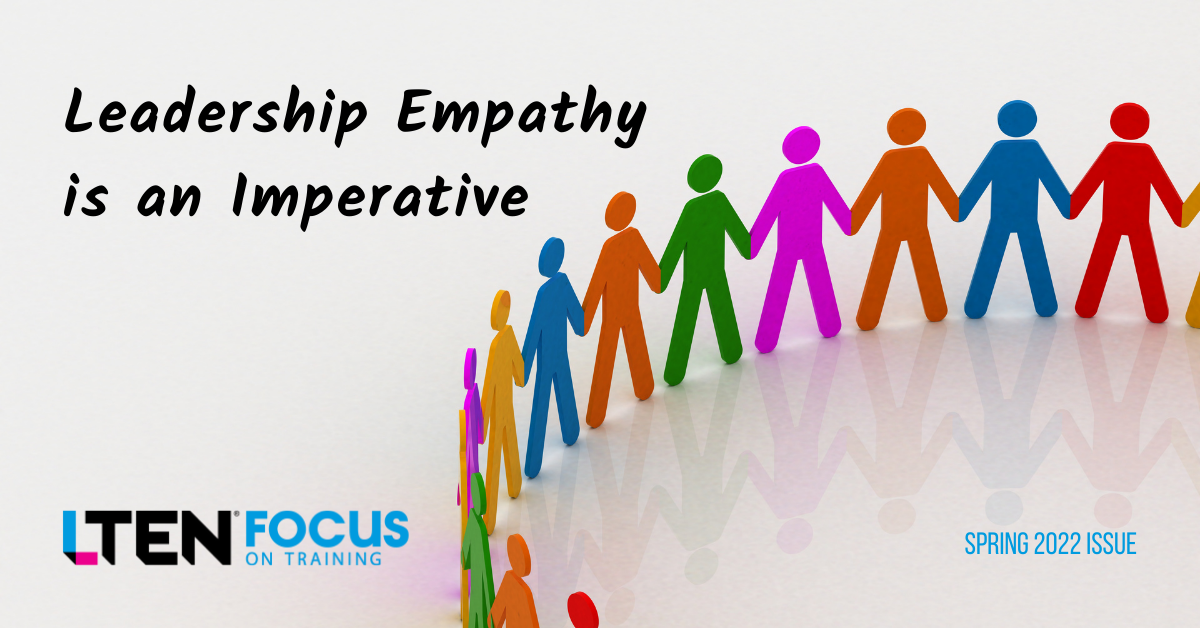
Leadership Empathy Is an Imperative
Leadership/Management Development – By Dr. Wendy Heckelman and Dr. Loretta Cate
 In today’s complex and increasingly unstable work environment, employees want leaders who seek to understand and accommodate their unique challenges and help them succeed, while still meeting company needs. With continued disruption in the workplace and increasing uncertainty about the future, many people are facing a variety of new, heightened or unforeseen personal and professional challenges.
In today’s complex and increasingly unstable work environment, employees want leaders who seek to understand and accommodate their unique challenges and help them succeed, while still meeting company needs. With continued disruption in the workplace and increasing uncertainty about the future, many people are facing a variety of new, heightened or unforeseen personal and professional challenges.
According to McKinsey & Company, employees, especially women, are facing more demands and greater personal impact from the COVID-19 pandemic, including:
- Anxiety over layoffs or furloughs.
- Burnout.
- Personal mental health issues.
- Childcare and/or homeschooling related problems.
- Mental and physical health of loved ones.
- Lack of financial security.
Leaders in nearly every organization are regularly presented with situations where direct reports experience one or more of these challenges and often struggle with providing clarity and direction. Leaders and trainers of leaders bear a great responsibility – to create and implement solutions that address these employee challenges. Developing and
improving leadership empathy is a very simple and powerful way to improve leaders’ effectiveness and impact.
Empathy as a Business Priority
Leadership empathy is the ability to understand others’ thoughts, feelings and rationale using inclusive behaviors. Leadership empathy has always been a part of effective leadership, but it has evolved to become a top business priority, with profound implications for the future of business, especially when employees face significant challenges.
As the pandemic and workplace disruption continue, so does the impact on work, childcare, healthcare, travel and social interactions. These additional employee stressors may lead to burnout or outright departure.
According to recent research by SHRM, many companies are struggling with increased employee burnout and turnover. Trends suggest that many companies have a shortage of leaders who effectively display leadership empathy. This supports developing stronger leadership empathy skills as a top priority for organizations, worldwide.
A mindset shift toward leading more empathetically calls for companies and leaders to be radically flexible in how, where and when work gets done and how they address employees’ unique personal situations. Leaders and companies unable to make this shift risk increasing employee burnout, reductions in performance and increased turnover.
 The Alarming Truth
The Alarming Truth
Over the past two years, compelling evidence has emerged regarding the leader behaviors that are valued most by employees and their organizations and evolving employee demands. In a 2021 Gartner survey of 4,787 global employees (assessing the evolving role of management) the authors argued that only 47% of managers are prepared to meet these demands and changes.
Further analysis revealed that leaders with high levels of empathy have as much as three times the positive impact on employee performance versus those with low levels of empathy. In addition, organizations with larger numbers of empathetic leaders were more than twice as likely to be viewed as having inclusive work environments.
Additional evidence demonstrated the positive impact of empathy on retention, engagement, work-life balance, collaboration, decisionmaking and the ability to engage in higher-value interactions with customers.
Common Perceived Barriers
To make leadership empathy behavior common in the workplace requires more than a conceptual understanding of why leadership empathy matters. Leaders across many organizations need to abandon several long-held assumptions about the employer-employee relationship, especially those beliefs based on dated business models.
Here are some common concerns voiced as barriers to leading empathetically:
- “As a leader, I know my people and what their challenges are.”
- “It takes time to be empathetic and with the increased pressure to perform it is just easier to tell them what to do versus discussing it.”
- “As an experienced leader, jumping in with solutions is what my people expect.”
These phrases, some of which you have heard before, are poor excuses for not developing leadership empathy skills and not demonstrating empathetic leadership behaviors.
Getting Started: Tips for Leaders & Learning Professionals
Developing leadership empathy should not be difficult, and the positive results from developing more empathetic leaders are significant. What practical steps can leaders take to lead more empathetically?
- Reflect on and understand both your own and others’ current situation(s).
- Seek others’ perspectives in an authentic and genuine way.
- Ask for feedback about your interactions with others and act on suggestions for improvement.
- Follow up on agreements and keep commitments.
Often, leaders struggle to maintain consistent behavior, jump to solutions too quickly or both. The key to effective leadership empathy is taking the time to develop a deep understanding of the person and their unique situation(s) genuinely and authentically. By avoiding assumptions to identify the root cause of challenges and involving them in the solution, leaders build trust and ensure their employees feel valued and respected.
Moving Behaviors Into Habits
By consistently demonstrating these impactful behaviors, leaders will better understand the unique situations of each direct report, be better able to lead, reduce employee burnout and turnover and elevate performance. Engaging inconsistently can be damaging and demoralizing.
To effectively develop and sustain leadership empathy, it is imperative that leaders develop a plan to shift mindsets and establish empathetic leadership behaviors as consistent, core practices.
To help shift mindsets and ensure empathetic leadership behaviors become habits, leaders must:
- Commit to the need for greater leadership empathy and assess their own reactions to a mindset shift.
- Construct a plan to assess, increase and sustain personal empathetic leadership capabilities.
- Create teams that empathetically engage their peers, collaborative partners and customers to deliver higher-value interactions and results.
- Coach direct reports empathetically to identify where they need help the most, and make them a part of the solution.
- Calibrate and establish metrics and milestones to assess the business impact of empathetic engagement at all levels (e.g., organizational, team and individual).
Conclusion
There is no cure-all to prevent turnover and burnout, or have employees that are always engaged; however, one path forward is to equip leaders with the tools, insights and skills to be more empathetic. There is no better time than the present for organizations to rethink how they identify and develop their current and future empathetic leaders.
Dr. Wendy Heckelman, wendy@wlhconsulting.com, is president and founder of WLH Consulting. Dr. Loretta Cate, Loretta@wlhconsulting.com, is principal, Access Leadership EDGE, and senior consultant for WLH Consulting.








